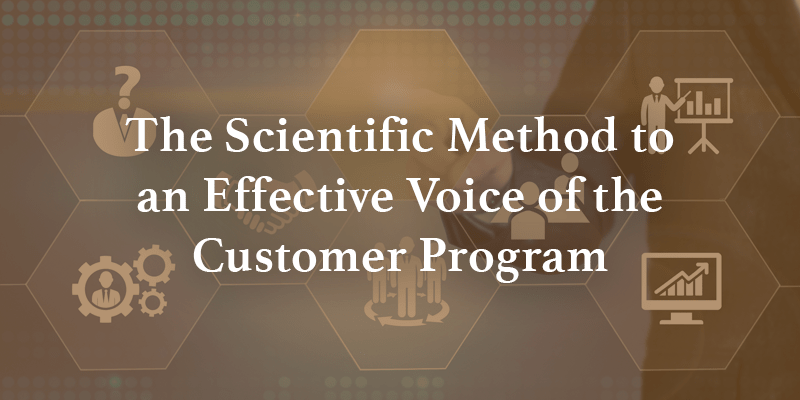I was thinking about our latest product package, Gainsight for Voice of the Customer (VoC), and naturally, my thoughts immediately turned to quantum mechanics.
And my question was this: Is there a quantum superposition for a customer in which they can be both healthy and at-risk simultaneously until observed by a CSM? In other words, could a customer be both renewed and churned at the same time?
Introducing Gainsight for Voice of the Customer
Let me back up a bit and explain Gainsight for VoC. We’ve always thought about our software (and Customer Success in general) as a transformative tool to comprehensively reshape companies at every level and across every function around their customers. We still believe that, but we frequently hear from potential customers who don’t feel they’re ready to take that kind of quantum leap right away. Plus, more than half of our customer base already use our Voice of Customer toolset, which was why we decided to unbundle as a way to get started with Gainsight.
The thing is, many companies are looking to take a concrete, tactical step right now to understand their customers’ behavior and sentiment, and take semi- or fully-automated action to influence them, all the while analyzing the results of those actions in a continuous, closed feedback loop. That’s why I’m so proud to go to market with Gainsight for VoC. It’s a new package that lets you start gathering feedback and closing the loop today.
But what does that have to do with subatomic physics?
Putting aside the fact that EVERYTHING has EVERYTHING to do with subatomic physics, I’ve noticed a very common problem in companies that manage Customer Success separately from Voice of Customer. In some cases, CSMs track open tickets and logins while Marketing or maybe Customer Experience (CX) is responsible for surveys and outreach. In any case, the solicited feedback and unsolicited (passive) feedback is decoupled.
I’ll give you a real world example: a company was getting NPS scores of nine or higher from an executive buyer. Meanwhile, almost no one was logging into the tool. Another company had a customer that never responded to surveys or outreach. Meanwhile, they were logging support tickets regularly.
In the absence of a tool or system that merges those data points into one picture, the customer is, in essence, both healthy and churning at once.
A quick explanation of Schrödinger’s cat
Now the physics part. You’ve probably heard the term “Schrödinger’s cat” before. Without explaining the nitty-gritty of the quantum mechanics of it, I’ll just lay out the idea. (Here’s a quick, cute video that talks a little bit about the physics and implications of Schrödinger’s cat.) In the famous thought experiment by physicist Erwin Schrödinger, you put a cat in a sealed steel box with a device that will either kill the cat or do nothing. The chances are 50/50. Is the cat alive or dead? According to quantum mechanics, the cat is both—a “superposition” of alive and dead at the same time—until you open the box and observe the state.
This isn’t just a silly philosophical paradox; it describes the real-world behavior of subatomic particles under observation. But it can also be used to metaphorically describe the real-world behavior of customers. Until you tie your Voice of Customer program to your Customer Success organization, your customers could be in an unresolved state that you won’t know about and you won’t be able to affect until it’s too late. (We won’t talk about a many-worlds theory of Customer Success in which ALL your customers exist in every state of health simultaneously.)
What’s the difference between Customer Success and Voice of the Customer?
Our point of view is that any successful VoC program rolls up to a broader Customer Success strategy. At Pulse this past year, I talked about how CS=CO+CX, as in Customer Success equals Customer Outcomes plus Customer Experience. I encourage you to watch the session to get my full perspective, but to sum it up, it means that the overall success of every customer isn’t just whether they get their desired outcome from the product, it’s also how they feel about it. It’s possible to get the ROI you paid for while having a terrible time interacting with the vendor. We know the opposite is also true!
Therefore, you need a strong focus on Customer Outcomes. It’s the single greatest indicator of renewal. Likewise, no Customer Success strategy is complete without a solid Voice of Customer component. It gives you insight into your customers’ experiences as well as whether they’re achieving their goals. But in the context of the new Gainsight package and this blog post, let’s quickly differentiate Customer Success from Voice of the Customer:
- Critical business philosophy, practice, and function
- Governs all customer-facing decisions
- Benchmarks customers based on data from many sources (including VoC)
- Takes action based on data to ensure successful customer behavior
- Operational program (may be tied to a specific function)
- Proactively solicits feedback from customers
- Finds and collects unsolicited feedback from customers
- Closes feedback loop with manual and automated communications
The Voice of the Customer is an integral data source—potentially the most important to your overall Customer Success strategy. These are your surveys, your one-to-many outreach, your social engagement, CSAT metrics, and CX data. Without actively pursuing and engaging with your customer’s direct feedback, you don’t have a complete Customer Success strategy.
Why you can’t do Voice of the Customer without Customer Success
But what about a standalone VoC program that doesn’t include traditional Customer Success actions and principles? Why not spin up an independent, single-function survey tool that lives in your Marketing team or maybe even your CX team if you have one?
I see three main reasons why a VoC program is fundamentally incomplete without being tied to Customer Success:
Voice of the Customer has blind spots: Like we discussed earlier, it’s possible to have solid survey results without having healthy customers. It’s possible (even likely) that the Voice of the Customer won’t match the behavior of the customer. That doesn’t invalidate either data source, it just means one is incomplete without the other. I’ll give you an example of how this could play out: You get a glowing NPS score from a C-level champion at a client. You reach out for advocacy, and produce a high-value, co-branded webinar. Finally, you operationalize a glowing online review from your champion. Pretty successful VoC campaign, right? Meanwhile, usage is completely in the tank. The end users have gone dark and unresolved tickets have been waiting for weeks. The customer churns and your valuable advocacy and content are liabilities.
Voice of the Customer needs to be mapped to specific customer outcomes: When we think about any business action or program at Gainsight, we always do so with goals in mind and metrics to track. That’s not radical—it’s typical. And it’s probably how things work at your company, too. The question is whether your VoC program correlates to your customer’s lifecycle and is mapped to a specific outcome. For example, a prototypical customer lifecycle might look something like: Closed Won→Onboarding→First Value→Executive Business Review→Renewal. VoC is most effective when feedback is associated with those transitions. We know that mistakes in onboarding are a major driver of unsuccessful customers and, therefore, churn. A survey outreach timed to coincide with the completion of onboarding can spot those mistakes and correct them. VoC done in a vacuum doesn’t correspond to the lifecycle and it doesn’t map to customer outcomes.
Voice of the Customer should be driving value across functions: There’s one last pitfall we see often in companies where VoC is independent of a broader Customer Success strategy. VoC has the potential to inform and transform every team with an external touch point, starting with Marketing, then Sales, then CS, CX, Support, and so on. No matter where your VoC program rolls up, whoever owns it must be responsible for surfacing data relevant to Support, for example, to improve Support. They must surface Product feedback to the Product team, Sales feedback to Sales. You get the idea. That’s starting to sound a lot like Customer Success, isn’t it? Customer Success is the only truly cross-functional team responsible for owning customer feedback and surfacing those insights to other organizations in the company. That survey that identifies a botched sales-handoff as a pain point needs to get into the hands of the Sales team. That tweet praising a first-class Support ticket resolution needs to get back to Support. Unless your VoC program is equipped to close that feedback loop, it’s not making the impact it should.
How to do Voice of Customer the right way
There are three broad parts of an effective Voice of the Customer program: Listen, Act, and Analyze. You can read more about how we think about VoC in the Customer Success business in our Essential Guide to Voice of the Customer. But I’ll really quickly sum them up:
- Listen: Asking and hearing what customers think, then responding.
- Act: Proactively improving the customer lifecycle based on that feedback.
- Analyze: Correlate what the customer says with what the customer does.
Obviously technology is a critical part of each of those steps. You need the capability to reach out, collect feedback, transform it into insight, and drive business actions. That’s why Gainsight for VoC isn’t just a standalone survey tool. Without action and analysis, listening is a dead end. If your VoC solution doesn’t have an action result or analysis capability, it’s only one-third of a solution.
Adobe’s use case is a great example of how a best practices Voice of Customer program can drive concrete improvements. I encourage you to check it out!

